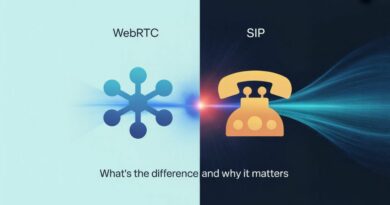WebRTC vs SIP: Understanding the Future of Internet Calling
When it comes to real-time communication, two acronyms dominate the conversation: WebRTC and SIP. Both play vital roles in enabling modern voice and video calling, yet they serve different purposes. For businesses and IT professionals, understanding the relationship between the two is essential for making the right technology choices.
What SIP Does Best
The Session Initiation Protocol (SIP) has been the backbone of VoIP for decades. It handles the signalling — setting up, managing, and tearing down calls. SIP works seamlessly with PBX systems and SIP servers, making it an industry standard for enterprise telephony.
For an authoritative background, see the SIP core specification (RFC 3261).
Platforms such as VitalPBX and OpenSIPS showcase how SIP has evolved into robust, flexible frameworks capable of supporting thousands of simultaneous calls.
Where WebRTC Changes the Game
While SIP manages signalling, WebRTC (Web Real-Time Communication) focuses on the media itself — audio, video, and data streams between browsers. Its standout feature is accessibility: users don’t need to install apps or configure devices; they can simply join a call directly from the browser.
For the formal standard, see the W3C WebRTC specification, and for developer-friendly guidance, MDN’s WebRTC guide.
Do WebRTC and SIP Compete or Complement?
Some assume WebRTC is a “replacement” for SIP, but that’s not entirely accurate. In practice, the two often work together:
- SIP handles the call setup.
- WebRTC delivers the encrypted media streams.
- Gateways like Janus bridge the gap between SIP infrastructure and browser clients.
This hybrid model allows businesses to keep their existing SIP servers while adding WebRTC for browser and mobile accessibility. Solutions like FusionPBX already integrate both technologies to give businesses the best of both worlds.
Practical Use Cases
- Call Centres: Combine SIP back-ends with WebRTC browser clients for agents.
- Telehealth: Secure, browser-based video calls without downloads.
- Remote Teams: Mobile-friendly collaboration tools powered by SIP + WebRTC.
And for businesses that don’t want to build integrations manually, services like Siperb offer a ready-to-use WebRTC SIP client designed to connect securely with existing PBX systems.
Final Thoughts
Far from being rivals, WebRTC and SIP complement one another. SIP provides the proven reliability of signalling, while WebRTC offers the flexibility and accessibility of modern browser technology.
Together, they’re shaping the future of VoIP and redefining how we connect in business and beyond.
For more articles like this, visit SoftpageCMS.



